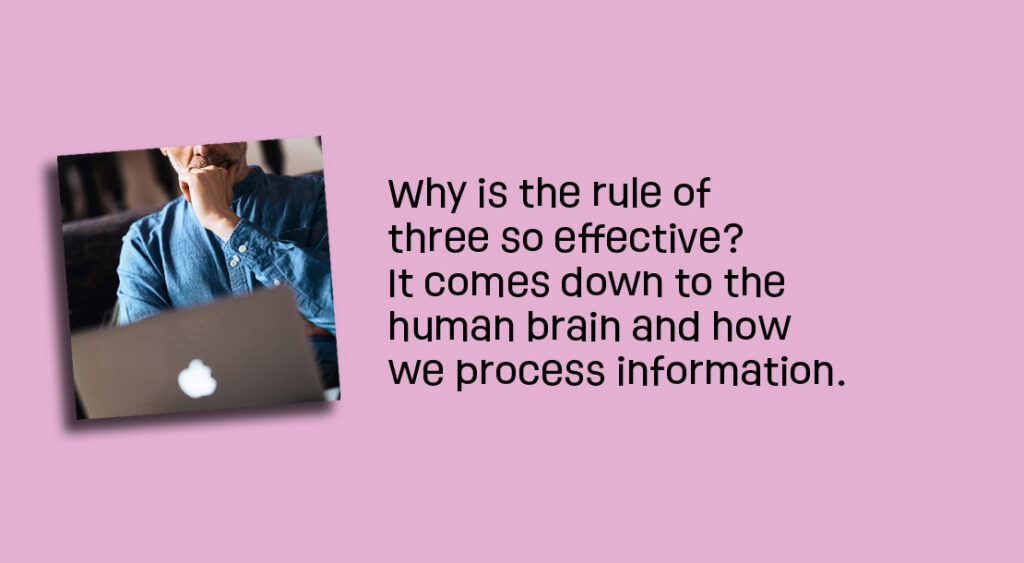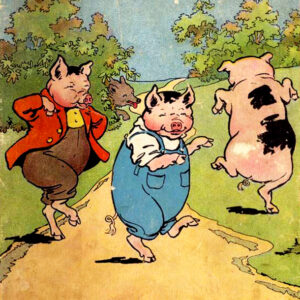What do sex, drugs and rock n’ roll and Heinz Baked Beans have in common?
They follow the rule of 3.
The rule of 3 is a principle you can apply to your copy to give it greater impact and make it more memorable.
Many familiar sayings come in threes – mind, body and spirit; faith, hope and charity; life, liberty and the pursuit of happiness.
Three is memorable. It lodges in the brain.
Some of the most famous phrases in advertising use the rule of 3:
Your Flexible Friend
That’s Asda Price
Just Do It.
Beanz Meanz Heinz.

Not all memorable taglines are three words long, but three is an optimum number to create a lasting impression.
Why is this rule of three so effective? It comes down to the human brain and how we process information.
Our brains look for patterns and systems to help us make sense of the world around us. This is pattern recognition.
Pattern recognition is a complex cognitive process in which the human brain discovers patterns and determines what they mean.
We do it every day. You might look up at the stars and identify a constellation or recognise the symmetry in leaf patterns on a tree. But this brain function also serves a useful purpose. Identifying patterns helps us determine probabilities and predict outcomes.
The brain stores information and makes connections between stuff it remembers and things it perceives in the present. It sees patterns in these memories and perceptions.
Patterns require a number or sequence of items. Three is the smallest number you need to form a pattern in your mind.
When you write content for your audience, they’ll read it and make certain associations based on your choice of words and sentences.
Applying the rule of three can help your ideas lodge more firmly in your readers’ minds.
Once you identify the rule of 3, it’s hard to ignore it. You can see it in a wide variety of writing, from fairy stories to literature, political speeches to marketing campaigns.
The rule of three applies to storytelling:

The rule of three is highly effective in rhetoric – using persuasive language to move an audience:
A sequence of three gives people a relatable pattern they can follow. It makes ideas hit home and helps the audience retain them for longer.
In comedy, the rule of 3 is also known as the triple.
It works like this. The comedian tells a joke that has three elements.
The first two of these elements are the set-up and the build-up. The second follows logically from the first, creating a narrative the audience can follow easily.
But the third element is the one that delivers the punchline because it upends what has gone before it.
Example:
When you die you see a light at the end of the tunnel. When my father dies, he’ll see the light, move towards it… then switch it off to save electricity.
The first item establishes the pattern. The second item reinforces it. The third item gives it an unexpected twist.
First you engage the audience, then you surprise them, giving your punchline impact.

Here are three ways to create compelling copy using the rule of three.
The basic structure of a written piece of copy is a beginning, middle and end:
2. Memorable sentences
Use groups of three words parallel in length or form. This is known as a tricolon.
A tricolon is a rhetorical device to make words and phrases more memorable.
It can involve the simple repetition of one word:
Location, location, location.
Or a repeated word pattern:
“My fellow citizens, I stand here today humbled by the task before us, grateful for the trust you have bestowed, mindful of the sacrifices borne by our ancestors.” (Barack Obama)
“Never in the field of human conflict was so much owed by so many to so few.” (Winston Churchill).
3. Three-in-one concepts
You can make three independent words work together consecutively to convey a single concept more powerfully and memorably.
This figure of speech is known as hendiatris. It adds emphasis to sentences and contributes to memorable taglines and sayings:

Three is a recurring motif in memorable writing. It’s not a hard and fast rule – you don’t have to follow the rule of 3 – but there are plenty of examples demonstrating its effectiveness.
Content must compete and to compete it needs to make an impression on its readers.
Following the rule of three is one way of helping your content make a stronger impression but it’s not the ONLY way.
Want to know more about creating compelling copy? Get in touch, or book a free, no-obligation introductory chat.